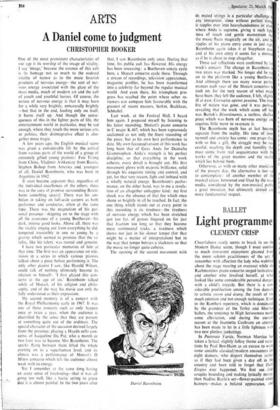Light programme
BALLET
CLEMENT CRISP Cheerfulness rarely seems to break in on the Modern Dance scene, though I must confess to much irreverent enjoyment gleaned from the more solemn practitioners of the art; l remember with affection the lady who wobbled about the stage wearing an overcoat while the Rachmaninov piano concerto surged to its close, and another who involved herself, at what looked like some considerable personal danger, with a child's tricycle. But there is a con- siderable predilection among the free dancers to artistic sturm and drang, the result of too much emotion and not enough technique. Even in the Rambert repertory, which is dominated by the grandeur of the Tetley and Morrice ballets, the tendency to High Seriousness needs some alleviation, and during the current season at the Jeannetta Cochrane an attempt has been made to let in a little lightness with two new plotless junketings.
In Pastorale Variee, Norman Morrice has taken a lyrical, slightly folksy theme and varia- tions by Paul Ben-Haim as an excuse to write some amiable classical/modern encounters for eight dancers, who disport themselves rather as if they had been given a day off in the country and been told to forget that Dark Elegies ever happened. We first see four couples bounding and making lyrically merry; then Nadine Baylis's set—flower-painted white banners—makes a belated appearance, and Mary Willis and Peter Curtis have an extended duet to a repeat of some of the music. The
piece lacks any emotional or dynamic focus, though its tranquillising effect probably makes it ideal viewing before catching an aeroplane.
The second piece in the aeration of the reper- tory is George Frideric, the first ballet by
Christopher Bruce, a fascinating and vastly talented soloist with the company. He has chosen a strongly shaped score, a Handel violin
sonata, and his three couples wear spectrum- shaded leotards with, because this is 1969, hippy bandeaux—arguably the least attractive head-dress since the Ku Klux Klan hood. Bruce has made fast-moving, rangy dances that set his cast high-stepping very handsomely; the effect is pleasing, and we must hope that a sharper individuality of style will come with greater experience. Curiously, the funniest piece in the reper- tory, John Chesworth's two year old Tic-tack, did not come off well. It is a zanily amusing cartoon about a newly married couple stripped to their buff leotards and joined hand to hand by a nail; she is all eagerness and button boots, he is a-blush with shame, reluctance and a bunch of strategically placed daisies. The piece has previously been a gift for the Ram- bert dancers, but this season only Jonathan Taylor, a superb artist, finds much fun in it. I imagine that there is some sort of moral here about all Modern work and no play . . .
Meanwhile, back at the Royal Opera House, an all-Ashton programme has been impeccably danced; beautifully judged performances in beautifully judged ballets gave the evening a bloom of perfection that is one of the rarest delights in the theatre.











































 Previous page
Previous page